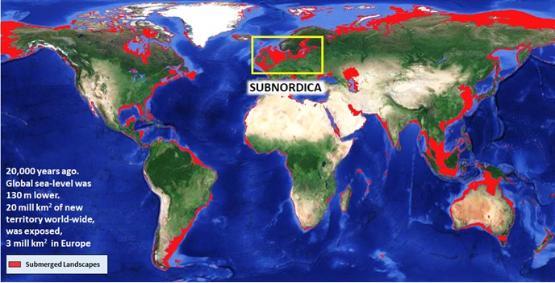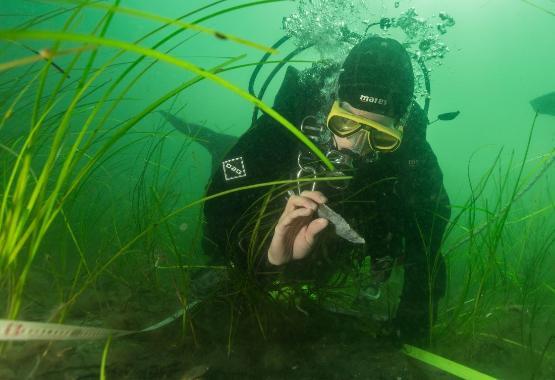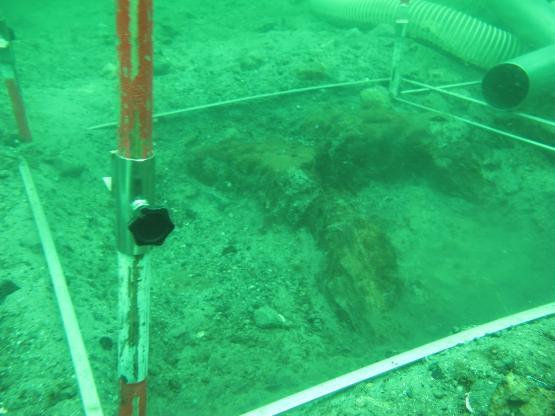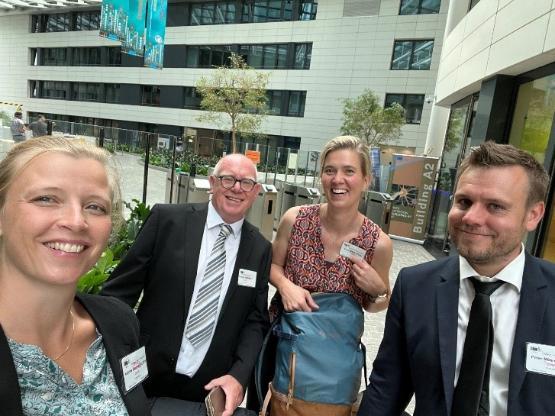University of Bradford wins £7m grant to hunt for lost civilisations beneath Baltic and North Sea
The University of Bradford’s Submerged Landscapes Research Centre, led by Professor Vince Gaffney, is about to embark on an ambitious project to map the seabed in the Baltic and North Seas, funded by an €8 million (just under £7 million) grant, the largest single grant ever awarded to the University.

The University is one of four key partners in a collaborative project starting early next year that received funding from the prestigious European Research Council. It will provide a deeper understanding of how our ancestors lived in areas now under the sea and comes at a crucial time, as wind farm developments are making these areas more inaccessible to researchers.

Image: Underwater excavation, example from the NIhK excavation at from Strande, Germany. (Photo: Christian Howe).
The EU has provided overall funding of more than €13.2 million for SUBNORDICA - a research collaboration between principal investigators from Moesgaard Museum, Aarhus University, the University of Bradford and the German research institute NIhK, to explore submerged landscapes in the North Sea and the Baltic. The project will apply the latest technologies to map the seabed, using AI and computer simulation to identify areas where long-lost settlements may still survive and can be explored, enabling ethical development of the seabed.
Twenty-thousand years ago, the global sea-level was 130 metres lower than the present... home to human societies for millennia... we know almost nothing about the people who lived on these great plains. SUBNORDICA will use the latest technologies to explore these lands.
Researchers at the University of Bradford’s Submerged Landscapes Research Centre will lead exploration in the southern North Sea alongside partner investigators from the Netherlands (TNO - Geological Survey of the Netherlands), Belgium (Flanders Marine Institute) and the University of York. Bradford will also host the project’s computing infrastructure, providing modelling and AI support for the quest to discover lost prehistoric settlements of the North Sea.

Image: 8,500-year-old tree stump at the bottom of Aarhus Bay, off the coast of Denmark. (Photo: Peter Moe Astrup).
SUBNORDICA is complimentary to Life on the Edge, Taken at the Flood and Unpath'd Waters research projects, all of which focus on marine palaeolandscapes.
Background
During the past two decades, archaeologists have become increasingly aware there is a major gap in our understanding of world prehistory. That gap is the 20 million km2 of new territory around the world that was exposed for thousands of years when the sea level was around 130 metres lower than today.
More than 3 million km2 of new land was exposed around-Europe’s present coastline, along with coastal plains, lakes, river valleys, shorelines and offshore islands which provided some of the most attractive land for prehistoric settlement anywhere in the continent. Now lost to the sea following global climate change, these landscapes remain almost entirely unexplored. Today, these landscapes are under threat as the world develops the coastal shelves to meet net zero goals
About the grant
The grant comes from the European Research Council, set up by the European Union in 2007 to fund research excellence in projects based across Europe. The funding is part of the Horizon Europe programme and is part of an overall budget of more than €16 billion from 2021 to 2027.
The grant awarded for this project is a Synergy Grant, the highest level available, which is awarded for ambitious projects which require collaborations from multiple institutions to meet their ambitious goals.
In this case there are four Principal Investigators (PIs) from Moesgaard Museum, Aarhus University, the University of Bradford and the German research institute NIHK who each bring specific expertise and experience.

Image: Principle Investigators: Dr Katrine Juul Andresen, Professor Vincent Gaffney, Dr Svea Mahlstedt, Dr Peter Moe Astrup. (Photo: Katrine Juul Andresen).
The Project Team
Professor Vincent Gaffney from the University of Bradford said: “Twenty-thousand years ago, the global sea level was 130 metres lower than at present. With progressive global warming and sea-level rise, unique landscapes, home to human societies for millennia, disappeared.
“We know almost nothing about the people who lived on these great plains. As Europe and the world approaches net zero, development of the coastal shelves is now a strategic priority. SUBNORDICA will use the latest technologies to explore these lands and support sustainable development."
Dr Peter Moe Astrup, underwater archaeologist at Moesgaard Museum, said: "SUBNORDICA will investigate the significance of ancient coastlines and its resources for humans. Through diving surveys in Aarhus Bay we will determine how widespread coastal settlements were compared to those in the interior and determine how marine resources were exploited 9000 to 8500 years ago.This knowledge will then be used to target archaeological investigations in less accessible areas.”
Dr Katrine Juul Andresen, marine geophysicist from Aarhus University said: “In SUBNORDICA, we will use the abundant legacy data in the form of geophysical 2D and 3D seismic and acoustic surveys and geological and geotechnical boreholes to understand what the Stone Age paleolandscapes looked like and how they evolved through time and during the flooding. By employing AI, we will make data integration feasible across the North Sea and Baltic Sea and further allow for automated interpretations of key landscape elements.”
Dr Svea Mahlstedt, Stone Age specialist and underwater archaeologist at the NIhK said: “The sunken landscapes in the North and Baltic Seas look back on a very similar past. Today, however, they differ significantly because the former land surface is much easier to reach in many areas of the Baltic Sea and therefore better investigated. We will use these accessible areas in the Baltic Sea to gain insights into the landscape use of the Stone Age inhabitants, their settlements and survival strategies. We will employ AI to apply the results to our data from the North Sea in order to uncover the secret of the North Sea.”
Institutions
Submerged Landscapes Research Centre, School of Archaeological and Forensic Sciences, University of Bradford.
The School of Archaeological and Forensic Sciences integrates Archaeological Sciences, Biological Anthropology, Cultural Archaeology and Forensic Sciences to study of societies and their environments in the present and the past. Our approach is profoundly multidisciplinary and brides the sciences and the humanities. This vision is promoted through the school's specialist groups including the Submerged Landscapes Centre, Biological Anthropology Research Centre, the Stable Isotope Centre and Visualisation Heritage. Together these provide the opportunity for archaeologists and forensic scientists use the latest technologies to capture, image, analyse and disseminate evidence for human activity and societies both from the past and the present.
The University of Bradford
At the University of Bradford, our focus is on creating the conditions for social, cultural, and economic impact. We will harness our strengths in research, innovation, teaching and partnerships to extend our reputation, influence, and impact. All of this will create a values-led culture that is inclusive and effective in enriching lives and benefitting society. https://www.bradford.ac.uk
Moesgaard Museum
Moesgaard Museum (MOMU) in Aarhus, Denmark, is to archaeology and ethnography, and collaborates with Aarhus University's department for archaeology on a range of research projects The museum and university also has shared employes, co-located in the same laboratories. The museum has responsibilities for land-based archaeology and underwater archaeology . It is a part of a formal collaboration (MAV) with three other museums located in western Denmark and which have underwater archaeological responsibilities. Moesgaard Museum also houses a natural science- and conservation department that works with material from both internal and external projects.
https://www.moesgaardmuseum.dk/en/
The Department of Geoscience, Aarhus University
The Department of Geoscience is a department within the Faculty of Natural Sciences at Aarhus University. We perform basic and applied research, and research-based education at the highest international levels based on in-depth understanding of the Earth system and with a clear view to the challenges of society and the UN Sustainable Development Goals. Geo-sensing, Geo-modelling and Geo-sustainability are key words in our research and education.
The SeisLab Aarhus research group at the department is dedicated to research and education using marine and land-based geophysical methods. Our main focus is on the reflection seismics and acoustic methods which we use for investigating shallow subsurface and deeper geological processes related to Quaternary landscape changes, geohazards, sedimentary basin evolution and structural geology. https://geo.au.dk/en/research/research-areas/department-groups/seislabaarhus
Aarhus University
Aarhus University (AU) is a public university recognized for the high quality of its research, research-based degree programs, and public sector government consultancy, in addition to value-creating collaboration with private businesses, public sector institutions and civil society. AU was founded in 1928 and subscribes to the fundamental values described in the Magna Carta of European Universities. Today its academic portfolio is broad ranging, from the classic university disciplines of the humanities, natural sciences, social sciences, health sciences and theology to business and engineering, educational theory and practice, and the environmental and agricultural sciences. This breadth gives the university a strong vantage point from which to combine disciplines in the creation of research breakthroughs, and to establish close collaboration with many sectors to the benefit of society. AU has around 38,000 students, 10,700 employees, 1,800 PhD-students and close to 1,000 postdoctoral scholars. Internationalisation is at the heart of AU’s mission and activities.
Niedersächsisches lnstitut für historische Küstenforschung
The Lower Saxony Institute for Historical Coastal Research (NIhK) in Wilhelmshaven is a non-university research institute in the German state of Lower Saxony. At the NIhK, natural and cultural sciences work closely together in an interdisciplinary manner, particularly in the disciplines of landscape and settlement archaeology, coastal and Quaternary geology, soil science, geophysics, historical geography, archaeobotany and vegetation history. They investigate the closely interwoven development of settlements, landscape and vegetation in the coastal zones of northern Germany and the neighboring landscapes from the end of the last ice age more than 12,000 years ago until modern times. https://nihk.de/
European Research Council
ERC Synergy Grants
The Synergy Grant scheme is aimed at a group of two to maximum four Principal Investigators (PIs) working together and bringing different skills and resources to tackle ambitious research problems. One Principal Investigator per research group can be hosted or engaged by an institution outside of the EU or Associated Countries. More information.
About the ERC
The ERC, set up by the European Union in 2007, is the premier European funding organisation for excellent frontier research. It funds creative researchers of any nationality and age, to run projects based across Europe. The ERC offers four core grant schemes: Starting Grants, Consolidator Grants, Advanced Grants and Synergy Grants. With its additional Proof of Concept Grant scheme, the ERC helps grantees to bridge the gap between their pioneering research and early phases of its commercialisation. The ERC is led by an independent governing body, the Scientific Council. Since November 2021, Maria Leptin is the President of the ERC. The overall ERC budget from 2021 to 2027 is more than €16 billion, as part of the Horizon Europe programme, under the responsibility of European Commissioner for Innovation, Research, Culture, Education and Youth, Iliana Ivanova.
ERC Press Contacts
Kerstin Dörflinger
Press and Communication officer Phone: +32 (0)2 29 650 59
Marcin Mońko
Press and Communication adviser Phone: +32 (0)2 29 666 44
Institution contacts
In the United Kingdom
University of Bradford
Press Office
Neil Hudson (media office) [email protected]
Steve Tillotson [email protected]
Academic Contacts
Prof. Vincent Gaffney ([email protected])
School of Archaeological and Forensic Sciences, University of Bradford
In Denmark
Moesgaard Museum
Press Office
Naja Kjærgård Laursen [email protected]
Academic contact
Dr Peter Moe Astrup, [email protected]
Archaeology Department
Tel: 50543642
Aarhus University
Press Office
Peter F. Gammelby, [email protected], +45 21 14 29 56
Academic contact
Dr. Katrine Juul Andresen, [email protected], +45 20 83 79 11
Department of Geoscience, SeisLab Aarhus
In Germany
Niedersachsisches lnstitut fur historische Kustenforschung
Press Office
Prof. Dr. Hauke Jöns, NIhK
[email protected] 49 4421 915112
and
Julia Streuer, Press Office Ministry for Science and Culture
Tel: +49 511 120 2624
E-Mail: [email protected]
Academic contact
Dr Svea Mahlstedt
Department for Cultural Sciences
+49 4421 915149
